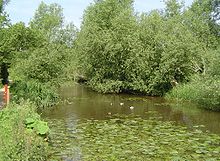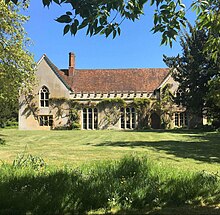Abingdon Abbey


Abingdon Abbey ( " St Mary's Abbey " ) was a Benedictine monastery located in the centre of Abingdon-on-Thames [a] beside the River Thames. [1]
The abbey was founded c.675 AD in honour of The Virgin Mary. [2]
The Domesday Book of 1086 informs us that the abbey was a wealthy and powerful landowner : [3] [c] [f]
There is nothing to see today of the abbey church. The existing buildings include : [6]
- Checker Hall ( Unicorn Theatre [7] ).
- The Checker. [6]
- The Long Gallery. [6]
- The Lower Hall. [6]
- Thames Street, the Mill and the Mill stream. [6]
Extant buildings

There is nothing to see today of the abbey church. Apparent ruins in the Abbey Gardens are Trendell's Folly, built in the nineteenth century. Some of the stones may come from St Helen's Church.[8]
Associated monastic buildings do, however, survive, including the Abbey Exchequer, the timber-framed Long Gallery, the Abbey bakehouse, (all in the care of the Friends of Abingdon Civic Society) the Abbey gateway, St John's hospitium (pilgrims' hostel) and the Church of Saint Nicolas. One of the original fireplaces was removed and is now still intact in Lacies Court, Abingdon School.[9]
The Unicorn Theatre is now located in part of the Abbey.[7]
History
Early history

The abbey was supposedly founded in 675 either by Cissa, viceroy of Centwine, king of the West Saxons, or by his nephew Hean, in honour of the Virgin Mary, for twelve Benedictine monks.[10] Cissa was buried here, as well.
Endowed by successive West Saxon kings, it grew in importance and wealth until its destruction by the Danes in the reign of King Alfred, and the sequestration of its estates by Alfred because the monks had not made him a sufficient requital for vanquishing their enemies. By the 950s the abbey was in a decayed state, but in about 954 King Eadred appointed Æthelwold, later Bishop of Winchester, abbot. He was one of the leaders of the English Benedictine Reform, and Abingdon then became the second centre of the Reform (after Glastonbury).[11] There is a collection of 136 charters granted to this abbey by various Saxon kings. [g]
The Chronicle of the Monastery of Abingdon was written at the Abbey in the 12th century.
Sutton Courtenay

In Sutton Courtenay, Abingdon Abbey constructed The Abbey as a monastic grange, used as an administrative centre for the abbey's land and tithe holdings.[12] However, the owner of the hide of land, Alwin the priest [13] ( whose father[14] owned the land before him ),[15] agreed with the abbot that he should retain Sutton with reversion first to his son and thereafter to the abbey, on condition of giving in Milton chapelry immediately.[16] Almost certainly in the late twelfth century, Abingdon Abbey took two thirds of the tithes and the rector the remaining third.[17] In 1258, following a dispute, the land was formally appropriated to the abbey and a vicarage was ordained.[18] As it was close to Abingdon Abbey, it was probably run by the monks themselves rather than being left to a steward.[12] In 1278, however, Hugh de Courtenay, Lord of the Manor of Sutton, sued the abbey for advowson. An allegedly biased jury was impanneled and in 1284 it found unexpectedly for Courtenay.[19] Solomon of Rochester, the chief justice of the eyre, who presided over the jury, was the first to be partitioned by the Courtenays.[20] The abbot of Abingdon Abbey alleged that in 1290, Solomon of Rochester had seized the goods in it belonging to the abbey. He also claimed that Solomon had extorted 40 marks from the abbey for alleged dilapidations to the rectory house.[21] He was not convicted of any offence.
Abbots
Abbots after the Norman Conquest included Faritius, physician to Henry I of England (1100–17), and Richard of Hendred, for whose appointment the King's consent was obtained in 1262. He was present at the Council of Lyon in 1272. The last abbot was Thomas Pentecost alias Rowland, who was among the first to acknowledge the Royal Supremacy. With the rest of his community he signed the surrender of his monastery in 1538, receiving the manor of Cumnor for life or until he had preferment to the extent of £223 per annum. The revenues of the Abbey (26 Hen. VIII) were valued at £1876, 10s, 9d.
Burials
Ælfric of Abingdon was originally buried here, before being translated to Canterbury Cathedral. Sideman (bishop) was buried here, too, as were Margaret, Countess of Pembroke, and Fulk FitzRoy.
- Other burials
- Robert D'Oyly and his wife Ealdgyth
- Siward (Abbot of Abingdon)
- Ralph Basset and his father Thurston Ralph Bassett
- John Grey, 2nd Viscount Lisle
- Margaret, Countess of Pembroke
- Mary of Waltham
See also
- Abbot of Abingdon
- Abingdon Monks' Map
- Cosener's House, a conference centre in the grounds of the Abbey
- Abingdon School
References
Notes
- ^ Abingdon-on-Thames was part of Berkshire until the 1974 boundary changes transferred it to Oxfordshire. See also :
- ^ See Abingdon Abbey > History > Early history > By the 950s the abbey was in a decayed state, but in about 954 King Eadred appointed Æthelwold, later Bishop of Winchester, abbot. He was one of the leaders of the English Benedictine Reform, and Abingdon then became the second centre of the Reform (after Glastonbury).
- ^ Sutton Courtenay and Abingdon Abbey ( Arthur Preston ) " At the time Æthelwold ( afterwards Bishop of Winchester ) took charge, the abbey was in a ruinous and impoverished condition. " [b] ... " In the course of Æthelwold's nine year rule, and as re-established and largely rebuilt by him, the abbey became the first of the Benedictine houses in England to undergo reform. " ... " From Æthelwold's time onwards its prosperous days may be reckoned, and during the next century or so great wealth was accumulated. In Domesday its possesions in Berks were given as second only in extent to the King's. " – PDF page 5, actual page 27. [4]
- ^ c.954 AD
- ^ Eadgifu was Eadred's mother.
- ^ Conquest, Reform and the Making of England (Martin J. Ryan) " There Æthelwold founded [d] – re-founded as he saw it – a monastery, staffed by former inmates of Glastonbury and clergy from London and Winchester, and was ordained its abbot. Abingdon subsequently received extensive grants of land from King Eadred and from Eadgifu [e] . " [5]
- ^ See Eadwig's Charter to Abingdon Abbey c.957
Citations
- ^ "MAGiC MaP : Abingdon Abbey (extant buildings)". Natural England - Magic in the Cloud.
- ^ Aveling 1913, p. 1.
- ^ *"Abingdon (St Mary), abbey of". Open Domesday. Retrieved 1 August 2022.
- ^ Preston 1919, p. 27.
- ^ Higham & Ryan 2015, p. 314.
- ^ a b c d e "History of the Buildings". The Friends of Abingdon Abbey Buildings Trust. Retrieved 1 August 2022.
- ^ a b "Unicorn Theatre". The Friends of Abingdon Abbey Buildings Trust. Retrieved 1 August 2022.
- ^ "Visit Abbey Gardens & Abbey Meadow". Abingdon-on-Thames Town Council. Retrieved 1 August 2022.
- ^ "Lacies Court, Abingdon School". Abingdon-on-Thames Town Council. Retrieved 1 August 2022.
- ^ "Abingdon Abbey". www.berkshirehistory.com. Royal Berkshire History, UK. Retrieved 5 February 2012.
- ^ Blair, John (2005). The Church in Anglo-Saxon Society. Oxford, UK: Oxford University Press. p. 350. ISBN 978-0-19-921117-3.
- ^ a b David Nash Ford (2004). "The Abbey at Sutton Courtenay". Royal Berkshire History. Retrieved 16 March 2020.
- ^ *"Alwin the priest". Open Domesday. Retrieved 1 August 2022.
- ^ *"Alwin the priest's father". Open Domesday. Retrieved 1 August 2022.
- ^ *"Sutton [Courtenay]". Open Domesday. Retrieved 1 August 2022.
- ^ Preston 1919, p. 28.
- ^ Preston 1919, p. 104-5.
- ^ Preston 1919, p. 106.
- ^ Preston 1919, p. 107-9.
- ^ Preston 1919, p. 109-110.
- ^ Rolls of Parliament, i. 58-9.
Sources
- Aveling, Francis (1913). Catholic Encyclopedia, Volume 1 - Abbey of Abingdon. Catholic Encyclopedia.
- Higham, Nicholas J.; Ryan, Martin J. (2015). The Anglo-Saxon World. YALE UNIVERSITY PRESS. ISBN 978-0-300-21613-4.
- Preston, A.E. (1919). "Sutton Courtenay and Abingdon Abbey" (PDF). Berkshire, Buckinghamshire, and Oxfordshire Archaeological Journal. XXV. Retrieved 1 August 2022.
 This article incorporates text from a publication now in the public domain: Herbermann, Charles, ed. (1913). "Abbey of Abingdon". Catholic Encyclopedia. New York: Robert Appleton Company.
This article incorporates text from a publication now in the public domain: Herbermann, Charles, ed. (1913). "Abbey of Abingdon". Catholic Encyclopedia. New York: Robert Appleton Company.
External links
- Abingdon Abbey Buildings The Friends of Abingdon Abbey Buildings Trust
- Abingdon (St Mary), abbey of Open Domesday
- Sutton Courtenay Open Domesday
- 7th-century establishments in England
- 1538 disestablishments in England
- Abingdon-on-Thames
- Anglo-Saxon monastic houses
- Benedictine monasteries in England
- Grade I listed buildings in Oxfordshire
- Grade I listed monasteries
- Monasteries in Berkshire
- Monasteries in Oxfordshire
- Christian monasteries established in the 7th century
- Monasteries dissolved under the English Reformation
- Churches completed in 675
- 7th-century church buildings in England

